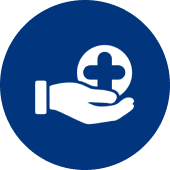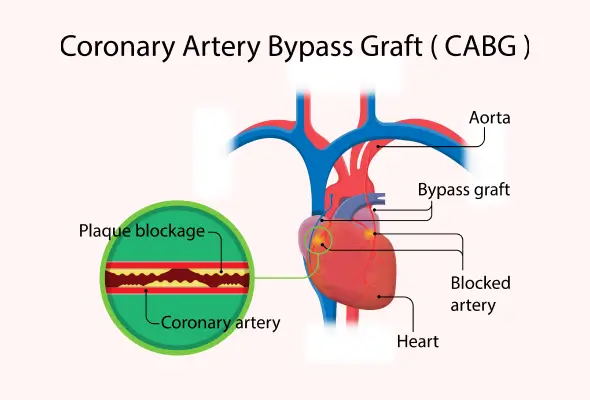-
Doctors
-
Specialities & Treatments
Centre of Excellence
Specialties
Treatments and Procedures
Hospitals & Directions HyderabadCARE Hospitals, Banjara Hills CARE Outpatient Centre, Banjara Hills CARE Hospitals, HITEC City CARE Hospitals, Nampally Gurunanak CARE Hospitals, Musheerabad CARE Hospitals Outpatient Centre, HITEC City CARE Hospitals, Malakpet
HyderabadCARE Hospitals, Banjara Hills CARE Outpatient Centre, Banjara Hills CARE Hospitals, HITEC City CARE Hospitals, Nampally Gurunanak CARE Hospitals, Musheerabad CARE Hospitals Outpatient Centre, HITEC City CARE Hospitals, Malakpet Raipur
Raipur
 Bhubaneswar
Bhubaneswar Visakhapatnam
Visakhapatnam
 Nagpur
Nagpur
 Indore
Indore
 Chh. Sambhajinagar
Chh. SambhajinagarClinics & Medical Centers
Book an AppointmentContact Us
Online Lab Reports
Book an Appointment
Consult Super-Specialist Doctors at CARE Hospitals

Beating Heart Surgery
Beating Heart Surgery
Coronary Artery Bypass Garf ( CABG ) Surgery in Hyderabad, India
Coronary Heart Disease can be caused when the arteries can not supply a sufficient amount of blood to the heart. In this case, the most recommended treatment is Coronary Artery Bypass Graft (CABG) surgery, also known as Beating Heart Surgery.
This surgery is performed at the OPCAB Surgery Hospital in Hyderabad while the heart is beating. During the surgery, the heart of the patient doesn't stop, nor does he require a heart-lung machine which means that the heart will continue to supply blood to the rest of the body.

Surgeons immobilize the area of the heart by using a tissue stabilization system. Beating heart surgery is also called Off-Pump Coronary Artery Bypass Surgery (OPCAB). This method restores blood flow to the heart. Moreover, it has been proven to have fewer side effects in some patients.
The coronary arteries transport nutrients and oxygen-rich blood to the heart. Atherosclerosis can cause the hardening of the arteries and narrow them gradually. When Atherosclerosis affects arteries that carry blood to the heart muscle, it is termed Coronary Heart Disease or Coronary Artery Disease.
The hardening occurs due to the deposition of bad cholesterol and other materials around the artery walls. This results in the formation of plaque that decreases the blood flow to the heart and causes chest pain or angina. Plaque can also form blood clots that can completely block blood flow causing a heart attack. Beating Heart Surgery can effectively restore the functioning of arteries.
What leads to beating heart surgery?
If an individual has coronary artery disease (CAD), he can manage it by changing their lifestyle, which includes proper food and exercise. However, in severe CAD cases, the patient might require CABG surgery. These treatments can help decrease the risk of a heart attack and chest pain. Sometimes, blockages aren't removed by angioplasty. That's when CABG surgeries come into the picture. But, before going for the surgery, the patient needs to understand the risks and benefits associated with the process. He can discuss the complications with his surgeon.
Once the patient and the surgeon have decided to go for CABG surgery, the next step is to choose the right one. Some people at high risk generally benefit from off-pump or beating heart surgery. These include patients suffering from severe CADs, chronic lung diseases, and kidney problems.
Off-pump surgery can decrease the chances of postoperative inflammation, irregular heartbeats, and infections. An experienced surgeon should perform this complicated surgery. Also, the patient should ask the healthcare professional about the benefits and risks of the surgery in the presence or absence of a heart-lung machine.
What are the risks associated with beating heart surgery?
Beating Heart Surgery or off-pump CABG comes with fewer complications as compared to CABG with a heart-lung machine. Risks vary according to the medical conditions of the patient, age, and other factors. In the future, the patient might need other CABG surgery after going for an off-pump CABG. Hence, the patient must clear all his concerns beforehand. Although off-pump CABG has provided positive outcomes to numerous patients, it still has some associated risks that include bleeding, infection, irregular heartbeats, kidney failure, blood clots causing a heart attack or stroke, complications from anaesthesia, etc. Age and other medical conditions may also contribute to these risks.
How to get ready for beating heart surgery?
Your healthcare team at CARE Hospitals will help you out with the OPCAB surgery. Meanwhile, the patient can follow the given suggestions.
-
Do not drink or eat after midnight or before the surgery.
-
Stop smoking before the operation.
-
Avoid taking some medications like warfarin tablets (anticoagulant tablets) before the surgery.
-
Follow the surgeon's instructions for medicine before the operation.
The patient may require some medical tests before the process to check their overall health before the operation. These include:
-
Chest X-ray
-
Blood Tests
-
Cardiac Stress Testing- for evaluating blood perfusion to the heart.
-
Electrocardiogram (EKG)- for evaluating the heart rhythm.
-
An echocardiogram is used to assess pump function and the structure of the heart.
If required, someone will remove skin above the area of operation an hour before the surgery. Moreover, the patient will also get some medicine to relax.
What happens in beating heart surgery?
Firstly, our surgeon applies anaesthesia, so the patient goes into a deep sleep without feeling any pain. The operation can take several hours depending on the situation.
The surgeon removes a part of a healthy artery or vein from an area of the body, maybe from the chest wall or leg. This part is called a graft.
The surgeon then attaches an extremity of a graft to a section above the blockage in the artery. The other extremity is attached to a part of the coronary artery below the blockage. Blood flow is restored when the graft is attached. It is difficult to sew or suture a beating heart. Therefore, the surgeon uses a stabilisation system to keep it steady.
The stabilization system consists of a tissue stabiliser and a heart positioner. The positioner holds and guides the heart in such a position so that the blocked arteries can be accessed by the surgeons easily. Similarly, the tissue stabiliser keeps a small area of the heart steady during operation.
In the case of minimally invasive off-pump CABG, the surgeon makes a small incision down in the middle of the patient's chest and separates a part of the breastbone. Sometimes, the healthcare providers can use special equipment and a camera during the surgery. In this method, the surgeon makes numerous tiny holes in the chest between the ribs.
What happens after beating heart surgery?
Right after the off-pump surgery
-
You might wake up after some hours of the surgery. He might be in a confused mental state after waking up, but after some time, he'll be conscious.
-
The recovery team carefully monitors your vital signs, such as your heartbeat. They use several machines to assist in continuous monitoring.
-
To facilitate breathing, the patient may have a tube in their throat. This can be a little uncomfortable and won't let the patient talk. However, it is removed after 24 hours.
-
You may also have a chest tube to drain excess fluid from the chest.
-
You may not feel pain after surgery, but you can feel some soreness. He can ask for painkillers if needed.
-
You will be able to perform daily activities like sitting and walking within 2 or 3 days after the operation.
-
You can drink fluids the day after CABG. He can have normal foods when he can tolerate them.
After leaving the hospital
-
You must make sure to have someone to drive him home. He will need some assistance at home also.
-
The stitches or staples are removed at a follow-up appointment after 8 to 10 days. Make sure to follow all the appointments on time.
-
You will recover strength, but it may take a certain number of weeks or so.
-
Don't drive until the surgeon tells the patient to do so.
-
Avoid picking heavyweights for a couple of weeks.
-
Follow the instructions provided by the healthcare provider regarding medicine, diet, exercise, and wound care.
-
The doctor can recommend a cardiac rehab programme that can help him regain his normal body functioning.
Things to know before going for the surgery
To avoid confusion, you should know the following things before moving ahead with the process or surgery:
-
The name of the procedure or test.
-
Reasons for the test.
-
What outcomes to expect and their meanings.
-
The dangers and advantages associated with the surgery.
-
Surgery's possible complications and side effects.
-
Location and timing of the process.
-
The performer of the surgery and his qualifications.
-
Consequences for not going for the surgery.
-
Any alternatives for treatment besides surgery.
-
Timings and processes for getting operation results.
-
Who can he (the patient) contact after the test to resolve health-related issues?
-
Cost of the surgery.
What are the advantages of this procedure?
Coronary artery bypass grafting (CABG) offers several advantages that have solidified its role as a valuable and commonly used method for addressing heart-related issues.
- Proven Track Record: CABG has a well-established history, with the first procedures performed in the early 1960s. Over subsequent decades, extensive research and advancements have cemented its status as a crucial and reliable approach for treating heart ischemia.
- Effective for Multiple or Specific Blockages: CABG is often the preferred choice when a patient has multiple blocked arteries in the heart or blockages in specific locations. Numerous studies have associated CABG with improved long-term outcomes, including enhanced chances of survival. This benefit is particularly pronounced when advanced bypass techniques are employed, yielding enduring results.
- Lower Risk of Subsequent Procedures: Comparatively, the main alternative to CABG is percutaneous coronary intervention (PCI), commonly known as angioplasty. In many cases, PCI carries a higher likelihood of requiring follow-up procedures.
What condition do these risks develop after the procedure
Coronary artery bypass grafting (CABG) is a major surgical procedure, and as with any surgery, there are potential risks and complications. While most of these risks are preventable or manageable, it's essential to be aware of them. These potential risks include:
- Irregular Heart Rhythms (Arrhythmias): Atrial fibrillation is the most common arrhythmia following CABG, which can increase the risk of stroke. Fortunately, this is typically a temporary issue.
- Bleeding: Bleeding is a risk in any major surgery. To mitigate this risk, individuals taking blood thinners may need to discontinue them under the guidance and monitoring of their healthcare provider before the surgery.
- Infections: Surgical procedures can carry the risk of infection. When infections spread throughout the body, they may lead to sepsis, a life-threatening immune system response. Sepsis is a medical emergency, and experiencing two or more of its symptoms (such as a rapid heart rate, fever, chills, confusion, and fast breathing) should be treated as seriously as a heart attack or stroke. Fortunately, major infections after CABG are rare due to improved surgical care and techniques.
- Confusion or Delirium: These conditions can manifest as symptoms like restlessness, cognitive difficulties, memory problems, or unusual behavior.
- Kidney Problems.
- Stroke.
- Heart Attack.
How Can CARE Hospitals Help?
Our multidisciplinary medical team at CARE Hospitals, which is a CABG/OPCAB Surgery Hospital in Hyderabad, performs the surgeries with advanced technology. CARE Hospitals also provide beating hearting surgery in Hyderabad with the support of the best medical unit, patients can recover quickly and can improve the quality of their lives. The infrastructure of the CARE Hospitals is highly advanced and all the needs of the patients are fulfilled. The staff also provides out-of-hospital support to solve the queries of the patients.
Frequently Asked Questions
Still Have a Question?

